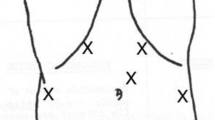Abstract
Laparoscopic esophageal myotomy is the standard surgical intervention for achalasia. Compared to standard laparoscopic techniques, use of the robot has theoretical advantages of improved visualization and dexterity. We evaluated the University of Arizona’s experience with the two alternatives to compare outcomes. Patients who underwent either laparoscopic or robot-assisted myotomy were identified from a retrospective database from 1/1/2006 to 12/31/2015. Patient demographics, prior treatment, intra-operative complications, operative time, post-operative length of stay and complications, and long-term results were compared between the two groups. We identified 35 laparoscopic and 37 robot-assisted Heller myotomies performed by multiple surgeons. Patient demographics were similar between the two groups with no statistical difference in age, gender, previous operations, pre-operative Botox or dilation treatment, or pre-op Eckardt score. In univariate analysis, the patients with the robotic procedure received a longer myotomy (5.85 cm vs. 5.56 cm for esophageal and 2.92 cm vs. 2.68 cm for gastric) and had a lower post-operative Eckardt score (0.51 vs. 1.09). A trend toward lower incidence of recurrent achalasia symptoms was found in the robotic group (0 patient vs. 4 patients) compared with those who had laparoscopic surgery (p < 0.05). Multivariate analysis showed that a longer gastric myotomy was associated with a lower recurrence rate (p = 0.0002). Both laparoscopic and robot-assisted Heller myotomy can provide definitive treatment of achalasia with good results and few complications. The mechanical advantage provided by the robotic approach may improve outcomes by providing a more complete myotomy and durable long-term result.

Similar content being viewed by others
References
Patti MG, Fisichella PM, Perretta S et al (2003) Impact of minimally invasive surgery on the treatment of esophageal achalasia: a decade of change. J Am Coll Surg 196:698–703 (discussion 703–705)
Hunter JG, Trus TL, Branum GD, Waring P (1997) Laparoscopic Heller myotomy and fundoplication for achalasia. Ann Surg 225(6):655–665
Vaezi MF, Pandolfino JE, Vela MF (2013) ACG clinical guideline: diagnosis and management of achalasia. Am J Gastroenterol. https://doi.org/10.1038/ajg.2013.196 (advance online publication 23 Jul 2013)
Zaninotto G, Costantini M, Molena D et al (2000) Treatment of esophageal achalasia with laparoscopic Heller myotomy and Dor partial fundoplication: prospective evaluation of 100 consecutive patients. J Gastrointest Surg 4:282–289
Finley RJ, Clifton JC, Stewart KC et al (2001) Laparoscopic Heller myotomy improves esophageal emptying and the symptoms of achalasia. Arch Surg 136:892–896
Csendes A, Velasco N, Braghetto I, Henriquez A (1981) A prospective randomized study comparing forceful dilatation and esophagomyotomy in patients with achalasia of the esophagus. Gastroenterology 80:789–795
Shimi S, Nathanson LK, Cuschieri A (1991) Laparoscopic cardio- myotomy for achalasia. J R Coll Surg Edinb 36:152–154
Patti MG, Pellegrini CA, Horgan S et al (1999) Minimally invasive surgery for achalasia: an 8-year experience with 168 patients. Ann Surg 230:587–593 (discussion 593–594)
Zaninotto G, Costantini M, Portal G, Battaglia G, Molena D et al. (2002) Etiology, diagnosis, and treatment of failures after laparoscopic Heller myotomy for achalasia. Ann Surg 235(2)186–192
Gockel I, Junginger T, Eckardt VF (2006) Long-term results of conventional Heller-myotomy in patients with achalasia: a prospective 20-year analysis. J Gastrointest Surg 10(10):1400–1408
Gockel I, Junginger T, Eckardt VF (2007) Persistent and recurrent achalasia after Heller myotomy. Arch Surg 142(11):1093–1097
Oelschlager BK, Chang L, Pellegrini CA (2003) Improved out-come after extended gastric myotomy for achalasia. Arch Surg 138:490–495 (discussion 495–497)
Galvani C, Gorodner MV, Moser F, Baptista M, Donahue P, Horgan S (2006) Laparoscopic Heller myotomy for achalasia facilitated by robotic assistance. Surg Endosc 20:1105–1112
Huffmanm LC, Pandalai PK, Boulton BJ, James L et al (2007) Robotic Heller myotomy: a safe operation with higher postoperative quality-of-life indices. Surgery 142:613–620
Horgan S, Galvani C, Gorodne M, Omelanczuck P et al (2005) Robotic-assisted Heller myotomy versus laparoscopic Heller myotomy for the treatment of esophageal achalasia: multicenter study. J Gastrointest Surg 9:1020–1030
Melvin WS, Dundon JM, Talamini M, Horgan S (2005) Computer-enhanced robotic telesurgery minimizes esophageal perforation during Heller myotomy. Surgery 138:553–559
Mandovra P, Kalikar V, Patel A, et al (2018) Redo laparoscopic heller‘s cardiomyotomy for recurrent achalasia: is laparoscopic surgery feasible? J Laparoendosc Adv Surg Tech A 28(3):298–301
Author information
Authors and Affiliations
Corresponding author
Ethics declarations
Conflict of interest
Authors Samuel Kim, Jose Guillen-Rodriquez and Alex Little declare that they have no conflict of interest.
Rights and permissions
About this article
Cite this article
Kim, S.S., Guillen-Rodriguez, J. & Little, A.G. Optimal surgical intervention for achalasia: laparoscopic or robotic approach. J Robotic Surg 13, 397–400 (2019). https://doi.org/10.1007/s11701-018-0865-7
Received:
Accepted:
Published:
Issue Date:
DOI: https://doi.org/10.1007/s11701-018-0865-7




